 Detail from Rowlandson's Masquerade Ball at the Pantheon, 1809
Detail from Rowlandson's Masquerade Ball at the Pantheon, 1809
Dressing for the Masquerade
 Detail from Rowlandson's Masquerade Ball at the Pantheon, 1809
Detail from Rowlandson's Masquerade Ball at the Pantheon, 1809
Arriving at the Masquerade, long before the rooms have begun to fill; with the awful farce of blank, lifeless buffoonery which presents itself at your entrance; till, at length, you are exhilirated by the average allowance of lethargic Harlequins, drunken Hermits, buckish Magicians, sneaking Emperors, august Tinkers, dejected Merry-Andrews, hoydening Abbesses, drivelling Minervas, lusty Ghosts, etc. etc. what little character there is lying exclusively among the Dominos.
-- from Bell's Court and Fashionable Magazine, Volume I, 1806
Regency Masquerade & Fancy Dress Images
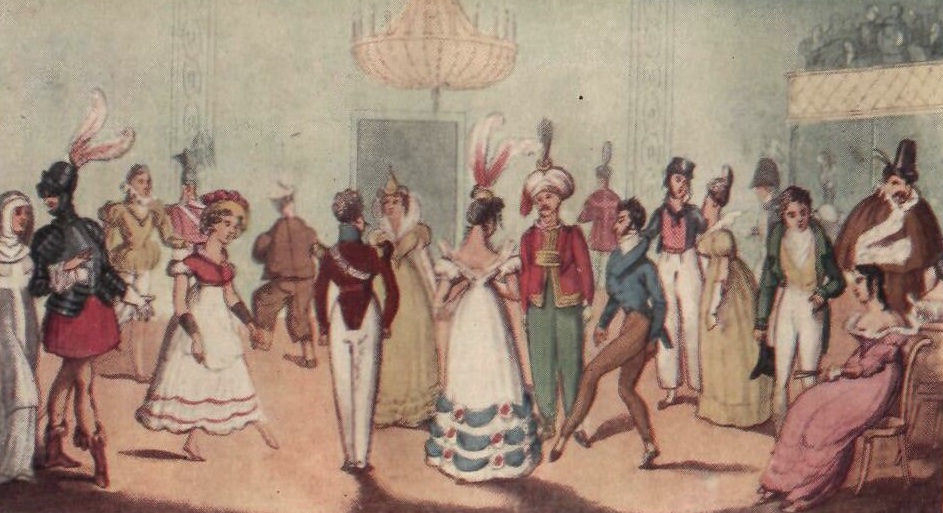 Here's an image from a Regency-era novel showing a fancy dress ball
(similar to a masquerade but without masks). At left there's a woman
dressed as a nun escorted by a gentleman in a knight's costume. In
the background there's a woman in a pseudo-Elizabethan outfit. Next
to them is a woman in pink and white whose headdress has a set of
pom-poms or flowers on it; she probably represents some abstract
concept. At center, a man in a Turkish costume shares a set with a man
in regular clothes and another in military uniform; clearly not
everyone felt impelled to dress in costume. Behind this group is a
man dressed as a sailor and a woman in some sort of
Renaissance-inspired outfit with a large white ruff.
Here's an image from a Regency-era novel showing a fancy dress ball
(similar to a masquerade but without masks). At left there's a woman
dressed as a nun escorted by a gentleman in a knight's costume. In
the background there's a woman in a pseudo-Elizabethan outfit. Next
to them is a woman in pink and white whose headdress has a set of
pom-poms or flowers on it; she probably represents some abstract
concept. At center, a man in a Turkish costume shares a set with a man
in regular clothes and another in military uniform; clearly not
everyone felt impelled to dress in costume. Behind this group is a
man dressed as a sailor and a woman in some sort of
Renaissance-inspired outfit with a large white ruff.
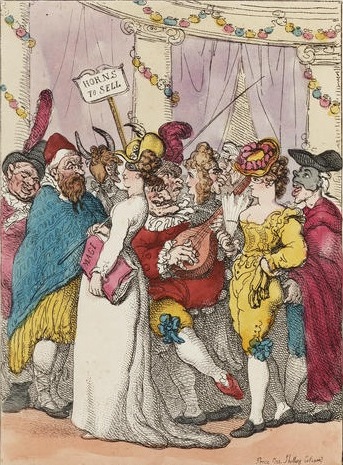 This 1811 image is from a caricature, so take it with a grain of salt.
The immorality of the masquerade is emphasized with the nearly
bare-breasted woman cross-dressed in front. The figure in the back
with horns and the "Horns to sell" sign represents cuckoldry. The
lute-playing musician at the front likewise suggests loose morals. At
right, a man wears a burgundy domino over his regular clothing with a
tricorn hat and mask. The woman in front with a large book is
probably a sorceress.
This 1811 image is from a caricature, so take it with a grain of salt.
The immorality of the masquerade is emphasized with the nearly
bare-breasted woman cross-dressed in front. The figure in the back
with horns and the "Horns to sell" sign represents cuckoldry. The
lute-playing musician at the front likewise suggests loose morals. At
right, a man wears a burgundy domino over his regular clothing with a
tricorn hat and mask. The woman in front with a large book is
probably a sorceress.
 This is a bit pre-Regency, a caricature from 1790 showing women
dressing for a masquerade ball. Again, don't take caricatures too
seriously as a guide! The woman standing on the chair is probably in
some sort of "Turkish" costume with her colorful headpiece. The woman
in front is cross-dressing in her knee breeches. The bare breasts
wouldn't have been part of the outfit; that's artistic license to
imply how improper masquerades were. Notice how simple the masks are
here; just little black half-masks or possibly (on the woman at far
right) a black scarf with eye holes.
This is a bit pre-Regency, a caricature from 1790 showing women
dressing for a masquerade ball. Again, don't take caricatures too
seriously as a guide! The woman standing on the chair is probably in
some sort of "Turkish" costume with her colorful headpiece. The woman
in front is cross-dressing in her knee breeches. The bare breasts
wouldn't have been part of the outfit; that's artistic license to
imply how improper masquerades were. Notice how simple the masks are
here; just little black half-masks or possibly (on the woman at far
right) a black scarf with eye holes.
Here's an actual fashion plate showing an "Egyptian" costume. You can
see that they were fairly flexible about accuracy! This illustration
is from the July, 1807, issue of the Regency magazine Beau
Monde and shows the Egyptian costume (left) next to a morning
dress. Here's the description:
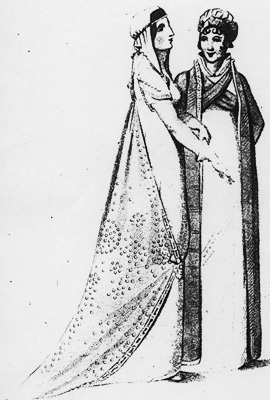 Fig. No. 1.--An Egyptian Costume.-- The head-dress is composed of a
rich handkerchief of white lace, which crosses the back part of the
head; each corner of the handkerchief, a small distance from the
shoulder, falls on the front of the neck; the handkerchief is trimmed
round with a magnificient border of peals, and each corner is finished
with a bunch of the same; the hair is curled on the top of the
forehead with small thick curls, separated with a band of diamonds,
which crosses the forehead, and continues round the head; two small
curls down the side of the face. A rich white figured sarsnet dress
made with a short trian, and scollope back; sleeves very short and
covered with a broad flap of white lace; the undersleeve is trimmed
round with small French pearls; also the lace, which is fastend to the
back part of the sarsnet sleeve with a star of pearls; the front is
made full each way, and covered with rich lace fastened in the centre
with a star to correspond with the sleeves. An Egyptian train of lilac
spider net, showered with pearls, and worked in the centre with a
large star of the same, cut in the form of a half handkerchief, wider
a one end than at the other; one end is cut square, and gathered up
full on the left shoulder with a pearl star; a piece of sarsnet, from
under the left arm, richly ornamented, crosses the front, and is
fastened with the middle corner of the train to the right knee with a
bunch of pearls; the other corner, which reaches to the bottom of the
dress, is finished with a large pearl tassel; the dress and train are
trimmed round with pearls to correspond. White kid gloves and shoes.
Fig. No. 1.--An Egyptian Costume.-- The head-dress is composed of a
rich handkerchief of white lace, which crosses the back part of the
head; each corner of the handkerchief, a small distance from the
shoulder, falls on the front of the neck; the handkerchief is trimmed
round with a magnificient border of peals, and each corner is finished
with a bunch of the same; the hair is curled on the top of the
forehead with small thick curls, separated with a band of diamonds,
which crosses the forehead, and continues round the head; two small
curls down the side of the face. A rich white figured sarsnet dress
made with a short trian, and scollope back; sleeves very short and
covered with a broad flap of white lace; the undersleeve is trimmed
round with small French pearls; also the lace, which is fastend to the
back part of the sarsnet sleeve with a star of pearls; the front is
made full each way, and covered with rich lace fastened in the centre
with a star to correspond with the sleeves. An Egyptian train of lilac
spider net, showered with pearls, and worked in the centre with a
large star of the same, cut in the form of a half handkerchief, wider
a one end than at the other; one end is cut square, and gathered up
full on the left shoulder with a pearl star; a piece of sarsnet, from
under the left arm, richly ornamented, crosses the front, and is
fastened with the middle corner of the train to the right knee with a
bunch of pearls; the other corner, which reaches to the bottom of the
dress, is finished with a large pearl tassel; the dress and train are
trimmed round with pearls to correspond. White kid gloves and shoes.
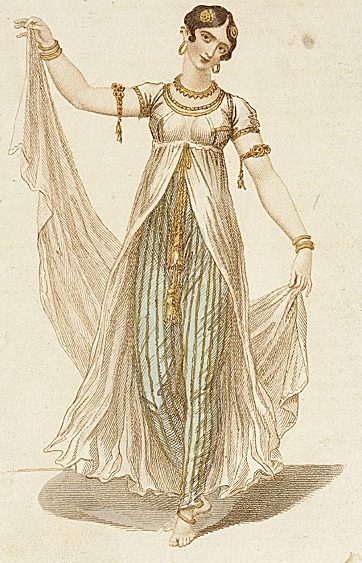 This is another plate from Beau Monde, from the November 1809
issue. I don't have any description for this one, and I'm not even
certain whether it was meant for masquerade or just a depiction of
foreign costume. It's labeled "A Lady of Hindoostan", which in this
context means India. It would certainly work for a masquerade, though
the trousers would be fairly shocking.
This is another plate from Beau Monde, from the November 1809
issue. I don't have any description for this one, and I'm not even
certain whether it was meant for masquerade or just a depiction of
foreign costume. It's labeled "A Lady of Hindoostan", which in this
context means India. It would certainly work for a masquerade, though
the trousers would be fairly shocking.
This is another fashion plate. It's post-Regency, from Ackerman's
Repository, 1829, but it's a good example of more elaborate "ethnic"
dress. It's labeled "Italian Costumes for Fancy Dress or Masquerade"
Here's the description:
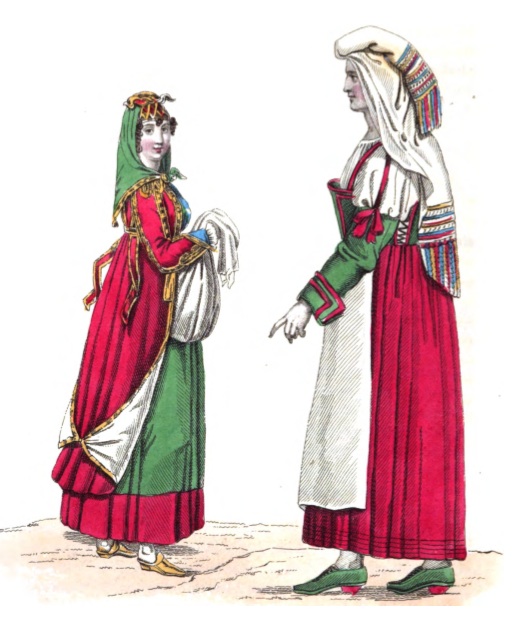 (Left) Costume of the Isle of Procida, Naples. Dress of twilled
sarsnet of a bright emerald colour, made high and plain, with a
stomacher of gold lace, the skirt terminated by a broad border of
scarlet cloth; the pelisse or surtout en militaire of scarlet
cloth, lined with white satin and edged with gold lace, the skirt is
open in front and reaches only to the border of the under dress; it is
turned back, and the corners fastened together behind a gold clasp.
The body and sleeves are made close to the shape and ornamented at the
seams with gold lace; bands of scarlet edged with gold hang loose from
the waist, which is encircled by a gold belt with a splendid clasp in
front; epaulettes to correspond; triangular cuffs of Tyrian blue
velvet edged with gold; ruffles of the finest lace.
(Left) Costume of the Isle of Procida, Naples. Dress of twilled
sarsnet of a bright emerald colour, made high and plain, with a
stomacher of gold lace, the skirt terminated by a broad border of
scarlet cloth; the pelisse or surtout en militaire of scarlet
cloth, lined with white satin and edged with gold lace, the skirt is
open in front and reaches only to the border of the under dress; it is
turned back, and the corners fastened together behind a gold clasp.
The body and sleeves are made close to the shape and ornamented at the
seams with gold lace; bands of scarlet edged with gold hang loose from
the waist, which is encircled by a gold belt with a splendid clasp in
front; epaulettes to correspond; triangular cuffs of Tyrian blue
velvet edged with gold; ruffles of the finest lace.
The hair
is confined, except a few curls on the temples, by a scarlet and gold
checquered silk fazzoletto, tied in front near the top of the
head and concealing the corner of a green silk barège
fazzoletto, which is edged with gold lace: the oppoite corner
reaches nearly as low as the waist and is ornamented with a gold
tassel; the other corners tie in a knot with long ends under the chin;
lace apron, white silk stockings, gold colour satin shoes, pointed on
the instep, lilac kid gloves.
(Right) Costume of Ostia, Rome. Camisole of fine lawn
made very full, and arranged in perpendicular plaits; the sleeves wide
and set in wristbands; stiffened bodice of green cashmere, bordered
and trimmed with geranium colour riband, open at the side, and laced
with green cord, displaying the camisole beneath. The
shoulder-straps are very long bands of geranium colour, and from the
centre of each descends a similar band reading to a green cashmere;
close upper sleeve, which extends half way between the shoulder and
the elbow, and is decorated by a bow of geranium colour riband; the
cuff is turned back, and has square corners, ornamented by two rows of
riband; geranium colour petticoat of Swiss stuff bordered by two rows
of narrow black velvet; apron of white lawn. Hair dressed a la
Madonna, entirely concealed by the head-dress, which is formed of
a delicate transparent white shawl, enlivened by ends embroidered in
rows of the brithest colours, and a deep fringe to correspond.
Michael Angelo has beautifully introduced this head-dress frequently
in his paintings; the half of the shawl is rolled up and placed on the
top of the head, the other half spreading wide over the shoulders, and
when the fair wearer chooses, closes in front, and conceals the face;
grey stockings, green shoes, with scarlet heels.